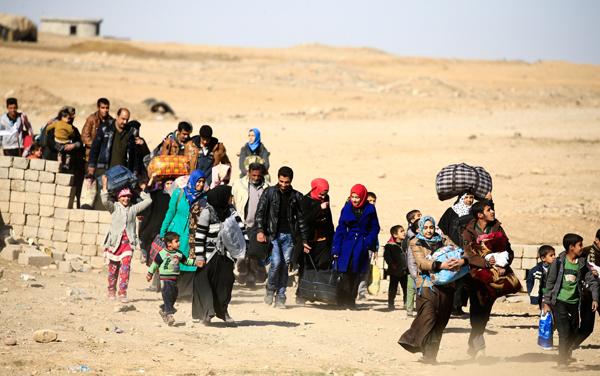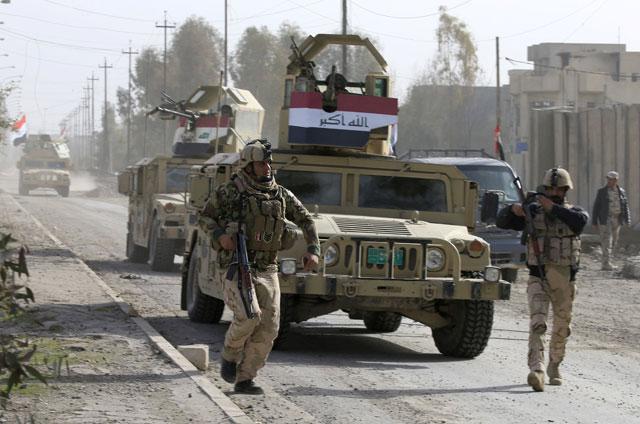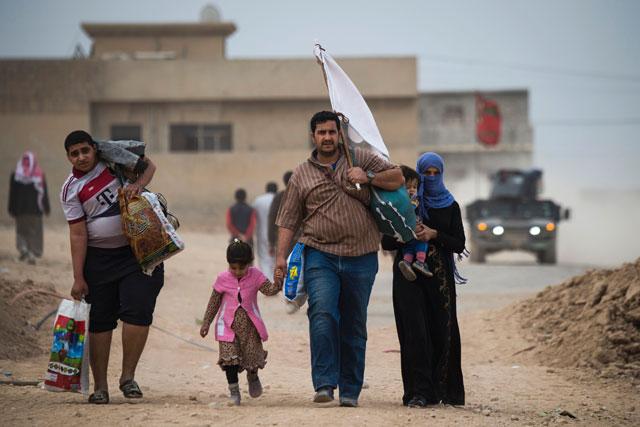You are here
Civilian victims of mortar, sniper fire pour into Mosul clinic
By Reuters - Nov 22,2016 - Last updated at Nov 22,2016

Displaced people fleeing from the Daesh terror group militants in Tahrir neighbourhood walk in Mosul, Iraq, on Tuesday (Reuters photo)
KOKJALI, Iraq — Iraqi military medics rushed a man whose mouth had been blown apart by mortar shrapnel into their temporary field clinic on the eastern edges of Mosul.
They bandaged the wound and gave him morphine as he gasped in pain, bleeding profusely onto a camp bed laid out in the courtyard of an abandoned home.
Seconds later, a boy with a large hole in his leg and one arm peppered with cuts from a shell blast was brought in on a stretcher. "That's already more than 30 people wounded today," a medic said. "And two dead."
All the victims are from areas closer to the centre of Mosul and which Iraqi forces recaptured from the Daesh terror group two weeks ago — but which they have sometimes struggled to secure as civilians remain within the range of the extremists’ mortar and sniper fire.
Black armoured vehicles sped into the clinic run by the elite Counter Terrorism Service (CTS) throughout the morning, ferrying in the casualties — an elderly man shot through the knee, another with a leg wound, a girl hit in the chest.
US-backed forces fighting to drive Daesh out of Mosul, the militant group's Iraqi stronghold, are facing stiff resistance from fighters using car bombs and human shields to slow their advance.
"Most casualties here are civilians," medic Mohammed, 23, said at the clinic in the Kokjali area. "Daesh shell randomly or target civilians with mortar and sniper fire. Most of the wounded are from mortars."
A Reuters correspondent also saw a wounded soldier brought back from the front line a few kilometres to the west.
Mortar shells fired by Daesh landed intermittently in the area while the medics from the CTS forces treated the wounded.
"Part of the problem is securing the areas the special forces have taken," Mohammed said. "If bigger army units or the federal police came in to clear the areas behind where CTS have advanced, maybe fewer people would be getting hurt, and it would make our job easier."
Dozens wounded
each day
Military doctor Captain Nizar said his comrades treated between 50 and 200 wounded civilians every day. "We had 25 civilian deaths yesterday," said Nizar, who did not give his full name.
Reuters could not independently verify casualty tolls, but in the time of two hours the correspondent saw one dead body and at least six other wounded including two serious cases.
The medics had put up a white flag with a red crescent close to the clinic. The building had been damaged by shellfire and was mostly empty apart from several camp beds used to treat patients.
A crude surgical table stood in the hallway, made of metal stands and a wooden board, surrounded by boxes of painkillers and wound dressings.
Captain Nizar said those who were more seriously wounded were taken to hospital, sometimes more than an hour's drive away in Erbil, capital of the Iraqi Kurdish autonomous region. For some, it was clear to the medics that it would already be too late.
Earlier, Ahmed Hussein wept standing over the body of his 17-year-old son Ayman, who had been shot through the back just half-an-hour before in Mosul's Zahra neighbourhood.
Ayman, his eyes closed and mouth open, was wrapped in a blanket placed on a stretcher outside the clinic after medics had tried in vain to save his life.
"It was a sniper, I think," 48-year-old Hussein said, his voice trembling. "The bullet went through next to his heart."
Related Articles
ERBIL /BAGHDAD — Iraqi forces pushed Daesh militants back further in Mosul on Tuesday in a renewed effort to seize the northern city and dea
MOSUL — The Daesh terror group militants shelled areas recaptured by Iraqi forces in western Mosul, hitting civilians fleeing the fighting e
MOSUL — Hundreds of Iraqi civilians spilled into the streets Tuesday in eastern Mosul areas recently retaken from the Daesh terror group to















